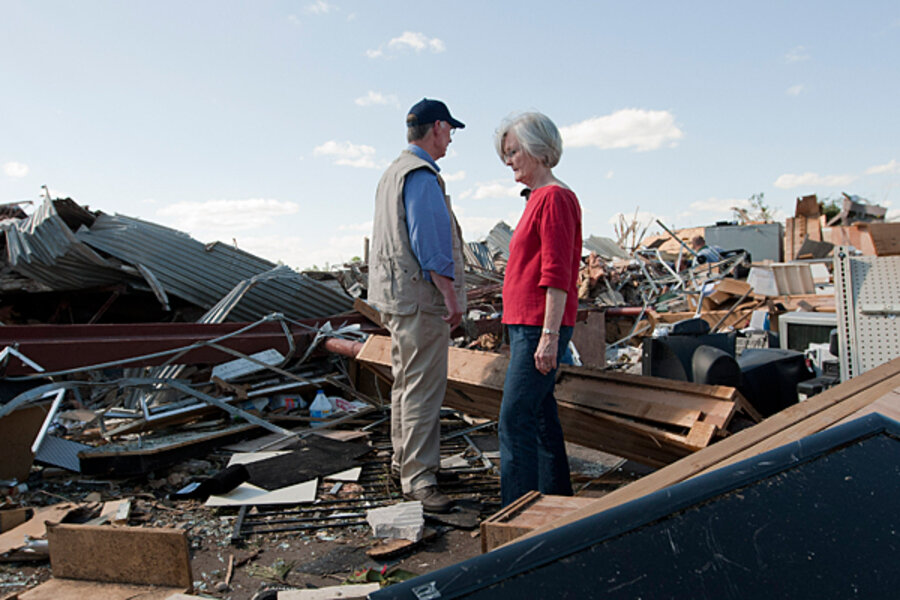With response to tornadoes, FEMA begins to rebuild its reputation
Loading...
| Atlanta
The designation of the Alabama tornadoes as a Category 1 disaster – the ranking given to 9/11 and hurricane Katrina – has put FEMA and its new director to the test.
Since taking the helm of the Federal Emergency Management Agency two years ago, Craig Fugate has begun a dramatic, common-sense revamp of national preparedness. He has led a Twitter-driven campaign to recalibrate American attitudes toward disasters and the role of FEMA amid the rubble.
In keeping with that do-something reputation, Mr. Fugate planned to be on the ground in Alabama Friday, to talk recovery with officials and hear from disaster survivors. Planned stops included an emergency command post in Phil Campbell, a Disaster Recovery Center in Hackelburg, and Bethel Baptist Church in Pleasant Grove.
With an estimated 328 dead and thousands homeless, the April 26-27 tornadoes became the agency’s biggest post-Katrina challenge. Early praise for FEMA’s response from Southern governors suggests that this may mark a turning point for the tarnished agency.
“In a big disaster like this, you usually start hearing complaints from state and local officials within at least 72 hours,” says David Schanzer, a homeland security expert at Duke University in Durham, N.C. “If you’re not hearing [complaints], it’s usually an important sign that things are going pretty well.”
In a marked contrast to the delay after hurricane Katrina, Fugate urged President Obama to declare Alabama a federal disaster area even before the harshest damage reports were in.
With at least 305 tornadoes reported in six states for the two-day period, it is the largest tornado outbreak in US history.
“If you can’t tell me it’s not bad, I’m going to assume it’s bad ... and go,” Fugate told The Associated Press, as he toured the area by air on May 1.
Appearing with Gov. Robert Bentley (R) of Ala-bama the day after the storms, Fugate reiterated that FEMA was taking a support role, then gave the governor the floor.
“It’s not FEMA’s role to step in midstream and take over, but to allow folks to do all they can and to let them know that there’s help if they need it,” says Edwin Bailey, who worked with Fugate in Achuala, Fla., as emergency responders. “Craig gets that.”
After hurricane Katrina, President Bush’s “heckuva job, Brownie,” to then-administrator Michael Brown, a lawyer and political appointee, came to symbolize the chasm between federal leadership and the situation on the ground. Mr. Brown resigned shortly thereafter.
Because the FEMA director is often a politico, Fugate, with no college degree and few political connections, made for an unorthodox appointee. He rose to the position by reputation alone: When Homeland Security Chief Janet Napolitano went looking for nominees, people just kept mentioning his name.
Fugate served as emergency management director for hurricane-prone Florida before taking the helm of FEMA. His first order of business was to demand that all FEMA employees have their own disaster readiness kits at home, part of his mission to reassess not only the agency’s response capability, but also the survival readiness of Americans.
As part of that strategy, FEMA now urges Americans to have at least seven days of provisions on hand at all times – up from three to five days. Fugate also rewrote the agency’s mission statement to replace “protect the nation from all hazards” with “support our citizens and first responders to ensure that as a nation we work together.”
“We tend to look at the public as a liability,” Fugate told the Atlantic Monthly in 2009, but “who is going to be the fastest responder when your house falls on your head? Your neighbor.”
In a way, disaster experts say, he has achieved more by promising less. “Fugate is trying, in essence, to retrain or manage the expectations of the citizenry of this country,” says Chris Emrich, who researches disaster preparedness at the University of South Carolina.
“We’ve become dependent on federal government for any kind of disaster, but ... I think what you’re going to see in Alabama is a transition from this idea of vulnerable populations” to a model of resilience.
To be sure, Fugate’s strength is as a first responder. But the ultimate determination of FEMA’s effectiveness will come in the drawn-out appeals and long-term recovery that stretch far beyond the disaster, says Gavin Smith, a natural hazards expert at the University of North Carolina in Chapel Hill.
Contributing to FEMA’s Success in the tornado-torn South is that many residents already epitomize the self-reliance Fugate preaches. FEMA outreach workers had to practically drag some people to the recovery centers where they could file paperwork for help. “We’ll set up tents. We’ll hunt,” one Alabamian told reporters.
FEMA quickly set up dozens of recovery centers and paid out $3 million in emergency aid within five days of the tornadoes. Fugate still wasn’t satisfied. For one thing, a delivery of blue roof tarps was behind schedule, as another rain front moved into the area.
Although many people, especially in remote rural areas, still hadn’t seen federal representatives a week after the storms, few voiced the resentment or sense of abandonment that dogged FEMA during the Katrina response.
Experts note that the comparison to 2005 is imperfect. Katrina was far more challenging overall. Many widely perceived failings in the response were not due to FEMA alone, but mismanagement by many government officials.
The agency’s new direction hasn’t been universally lauded. In early May, Gov. Rick Perry (R) criticized FEMA for failing to designate most of Texas a natural disaster, after 9,000 wildfires ravaged his state.
But FEMA’s response to the tornadoes has been well received. “Where the federal response is concerned, there’s little to criticize and much to praise,” opined The Birmingham News editorial board on May 4. “That’s very encouraging, indeed.”





